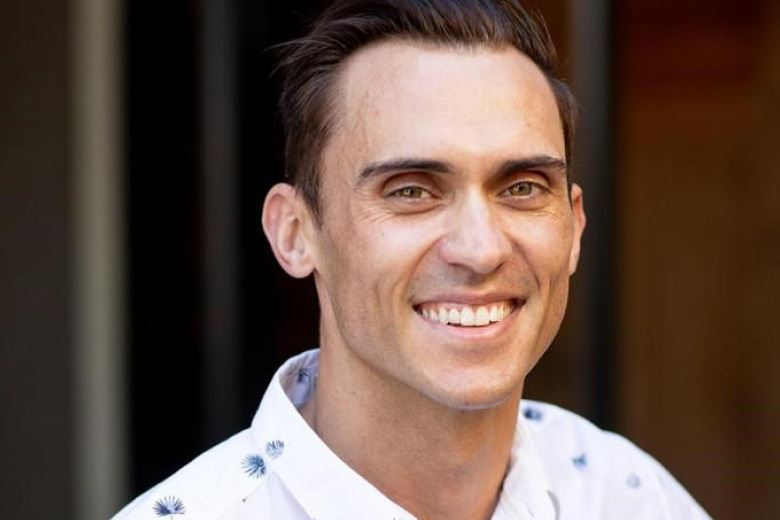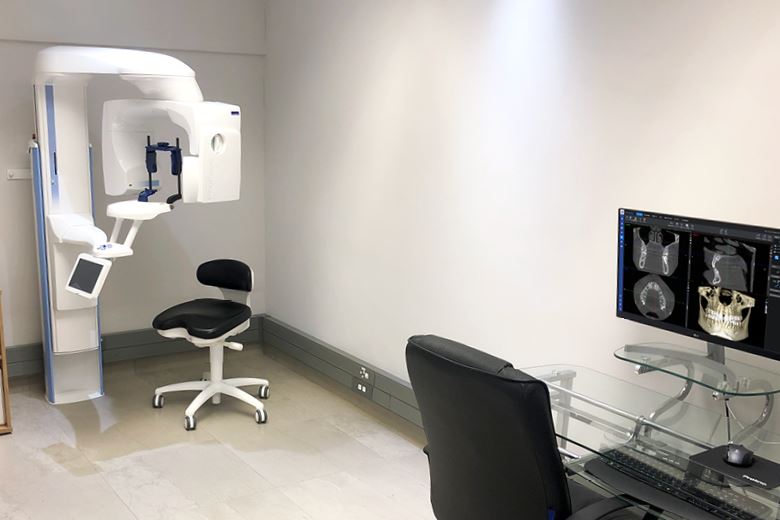Giving back to the community through digital dentistry
Having a great dentist as a child may sometimes lead you to choose the same profession yourself. This happened to Dr John Olivin Glen-Spyron. With a strong passion for improving people’s health and quality of life, he now runs his own dental clinic, Institute for Oral Health Namibia.

Dr John Olivin Glen-Spyron grew up in Windhoek, the capital of Namibia. At school, he was into chemistry, physics and mathematics. Although he had a special interest in medicine early on, he also considered studying chemical engineering but soon realised that he was too much of an extrovert for that career path to work out. It was the exceptionally skillful dentist he had growing up that got him interested in the art and science of facial aesthetics and changing people’s lives.
Becoming a dentist was quite a long journey for Dr Glen-Spyron, though, and it took him nearly 15 years all together. After completing his bachelor’s degree at the University of Pretoria in South Africa, he worked at a private practice for nearly 10 years. During these years, he also started his postgraduate studies at the university and studied at Dr Howard Gluckman’s Implant and Aesthetic Academy in Cape Town. In 2018, he eventually completed his master’s degree, specialising in periodontics, implantology and oral medicine. He also holds a post-graduate diploma in orthodontics.
Giving back to the community
According to Dr Glen-Spyron, there are approximately 80–120 dentists in Namibia and only a few medical or dental specialists. When he was still a post-graduate student, he realised that, in fact, there was no periodontist in Namibia at all. The fact that Africa has a very high incidence of diabetes and Cholera – both illnesses that have found to have a connection with periodontal diseases – was one of the key reasons that led him to specialise in periodontics.
His speciality of choice did not go unnoticed in Namibia. While Dr Glen-Spyron was still studying and working in South Africa, many patients from Namibia started visiting him. At the same time, several dentists from his native country started asking, whether he would consider returning to Namibia. After finishing his degree, Dr Glen-Spyron decided it was time to move back. After all, his entire family lives in Namibia. Another important reason was the aspiration to give back to the community where he grew up.
Dr John Olivin Glen-Spyron started his own practice, Institute for Oral Health Namibia, in Windhoek in 2019. In addition to improving the oral health and overall quality of life of the residents of his community, the idea behind starting his own practice was to ensure frequent visits from dental specialists to Namibia.
The clinic offers a holistic approach on patients’ health by providing a wide variety of services in the areas of periodontics, implantology, oral surgery and oral medicine. In the future, Dr Glen-Spyron is hoping to be able to bring in maxillofacial and prosthodontic specialists as well. The clinic is still in a growing stage, but he is determined to build a steady network of regularly visiting specialists to benefit the local community.

Dr John Olivin Glen-Spyron’s clinic, Institute for Oral Health Namibia, provides a wide range of dental services to the local community in Windhoek, Namibia.
The transformational switch to digital dentistry
As an undergraduate student, Dr Glen-Spyron had very limited access to digital systems and therefore got used to taking analogue radiographs, such as periapical and panoramic X-rays.
When he started working at a private practice, he was properly introduced to digital dentistry. “It made all the difference – the ease of use, low patient dose, image quality and image customisation was simply mind-blowing!”
Dr Glen-Spyron believes there is no going back from CBCT, ultra-low dose imaging and the improved image quality. “With the amount of information CBCT provides, it is inevitably the future of periodontics, implantology and oral surgery.”
In addition, he strongly advocates the digital workflow. “These days, the ease of communication with other dentists and specialist is fantastic! Case presentation is so much easier, when I can just export images and PDFs to specialists for discussion.” He continues that digitalisation has improved lab techniques, as he can scan models, send them to a lab and have them 3D printed. In addition, digital models can easily be incorporated into the implant planning software.
The benefits of digital dentistry for the patients cannot be overlooked, either. For example, as opposed to making laborious impressions for patients, Dr Glen-Spyron now does a fast intraoral scan instead. He uses intraoral scans and digital models to visualise the treatment process and the end result for the patient. He feels this enables better patient satisfaction and commitment to treatment.
“Patients often have unrealistic expectations of what can be achieved by a certain treatment. The more digital information you have, the easier it is to take them through the whole process. Knowing what to expect, they are more likely to be satisfied with the result.”
The future is digital
Although the transition to digital dentistry was a natural progression for him, Dr John Olivin Glen-Spyron understands not everyone shares his opinion. He says that often dentists, even the younger generation, tend to be stuck on doing things the way they were once taught and the way they have always done them.
“I always recommend people at least discussing with a colleague who is already practising digital dentistry, perhaps trying out the digital workflow and then incorporating it into their own practice.” He believes this is the only way to determine, whether it works for them or not.
“At the end of the day, digital dentistry is more comfortable for me and my patients, it’s more cost-efficient and it gives the patients better aesthetic results – and that is what they are buying to. If the patients are not buying your treatment plans, your practice is going to be struggling,” he says.

Dr Glen-Spyron uses the Planmeca ProMax® 3D Plus CBCT unit together with the Planmeca Romexis® software platform.
Sights trained on top-quality equipment
Having worked in different practices, Dr Glen-Spyron has experience of various dental equipment manufacturers. “Using different brands gives you a rather good idea of what you like and what you don’t like,” he states. He got his first touch on Planmeca devices when he returned to complete his post-graduate studies and the university had acquired a Planmeca CBCT unit. Even then, he was impressed by the quality of the device.
When choosing equipment for his own practice, he was looking for long-lasting products that would provide both excellent ergonomics for the user and first-rate care and comfort for the patient. Planmeca was at the top of his list, but he wanted to investigate different options available on the market to make sure he made the best investment for his clinic.
In the end, the decision was easy. “The customisation of some of the Planmeca devices was just miles above anything else.” He was also fascinated by the high quality and durability of the materials, such as the aluminium base. Nowadays Dr Glen-Spyron’s clinic has a Planmeca ProMax® 3D Plus CBCT unit, a Planmeca Chair™ and a Planmeca ProX™ intraoral X-ray unit with an integrated Planmeca ProSensor® HD intraoral sensor – and he intends to expand his range of equipment when the time is right.
He also uses the Planmeca Romexis® software daily. He was first introduced to Romexis at the university, where they had an older version of the software. Nobody taught him how to use the software, but he learned by experimenting himself and by watching the Romexis tutorial videos. “The quality of the images and the ease of use was just phenomenal – it was like a night and day difference to all the other software I had previously tried,” he says.
Last year, he upgraded to version 6.0 of the software and could not be happier. “Romexis 6 takes usability to a completely new level – the software is practically self-explanatory.” If he had to name his favourite module, it would be Romexis® 3D Implant Guide. “The implant planning capabilities of the software are extraordinary. I’m especially impressed by the size of the implant library of Romexis and how often it is updated.”
According to Dr Glen-Spyron, what makes Planmeca different to other manufacturers is that Planmeca really listens to the feedback dental professionals provide. “The R&D team is always willing to look at altering their ideas. They are not just changing things for the sake of changing things. They are changing things to really benefit people.”
Copy: Hanna Lipiäinen
Images: Susan Nel and John Olivin Glen-Spyron
Planmeca Oy and Planmeca Group
Planmeca Oy is one of the world's leading dental equipment manufacturers with a product range covering digital dental units, CAD/CAM solutions, world-class 2D and 3D imaging devices and comprehensive software solutions. Headquartered in Helsinki, Finland, Planmeca’s products are distributed in over 120 countries worldwide. With a strong commitment to pioneering innovations and design, it is the largest privately held company in its field. Planmeca Oy is part of the Finnish Planmeca Group, which operates in the field of healthcare technology. The Group's turnover in 2020 was MEUR 764, and it employs nearly 2,900 people worldwide.
www.planmeca.com
Tags:




